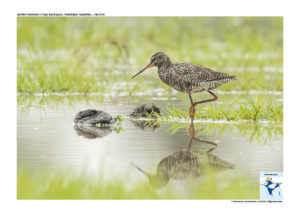Spotted Redshank

Spotted Redshank Tringa erythropus
Etymology:
- Tringa : Greek word for trungasthrush-sized, white-rumped wading bird that bobs its tail, mentioned by Aristotle
- Erythropus : Greek word eruthros –red; pous –foot
Vernacular names: Hindi: SurmaBatan, Gatni, Surma, Pun: China lalchaha, Mani: Ngahoibi, Guj: Rakhodiyoratapug, Kalithuthvari, Ta: Pavalakaalullan, Te: Yerrakalulanka, Mar: ThipkyanchaTilawa
Distribution in India: Widespread Winter visitor in India (Only in some parts of East India)
Description: Size of 29-32 cm. It is an elegant wader, with long neck, legs and bill; entirely black, with white dots on upperparts, and often variable amounts of whitish on underparts; in flight, shows white wedge on back and white underwing. The female is similar, slightly larger and generally paler, with white tips to crown feathers and more white fringes on underparts. The non-breeding adult has contrasting dark eyestripe and white supercilium, ash-grey upperparts with white fringes, plain grey breast and white underparts. The juvenile is darker than non-breeding adult; upperparts, head and breast are brownish with dense white marks; underparts are paler and densely barred
Habitat: It is found in Open wooded tundra, swampy pine or birch forest near tree line, and more open areas such as heath land and shrub tundra. After breeding found in variety of freshwater or brackish wetlands, including sewage farms, irrigated rice fields, brackish lagoons, salt marshes, salt pans and sheltered muddy shores along coast.
Food Habits: It eats small fish, crustaceans, molluscs and many insects; sometimes plant matter like seeds. When feeding on fish, it may forage socially in dense flock of conspecifics or mixed with other Tringa species, occasionally even with Great White Pelicans and dabbling ducks, moving erratically while pecking at prey or running synchronously in one direction, while each bird sweeps bill through water. It occasionally swims while feeding in deep water; may immerse head and neck completely, sometimes even upending like surface-feeding duck, moving legs to maintain balance. It pecks, probes, jabs or sweeps bill through water from side to side. It is found mostly in small flocks, occasionally up to several 100s, sometimes singly. It is a diurnal and nocturnal feeder.
Breeding Habits: They breed in May-June in the Arctic across much of Eurasia, from Lapland in the west to Chukotskaya in the east. They are monogamous.The nest is a shallow depression, usually in grass tussocks or moss, sometimes near tree branch or stone, sparsely lined with plant material like grass, dead leaves, pine needles, stems and few feathers. They lay a clutch of 3-5 eggs, with laying interval of 35-43 hours. The incubation period is 20-23 days. Incubation is done by both sexes, mainly by female from last egg.Both sexes tend chicks at first, but female may leave before fledging. The fledging period is 28 days.